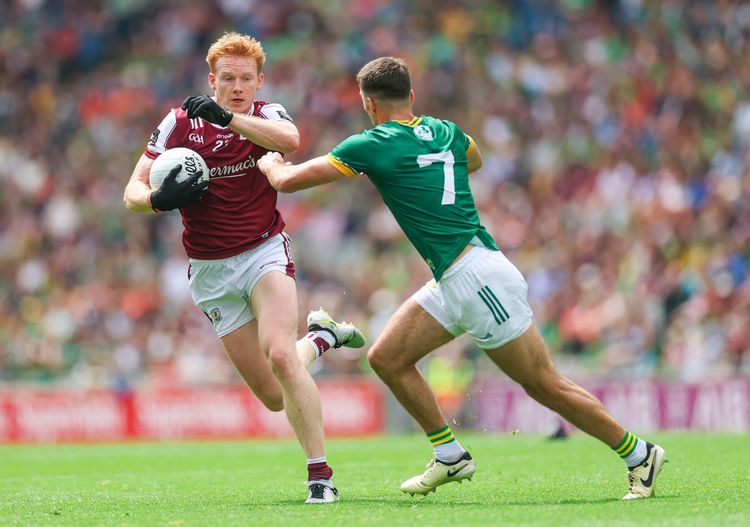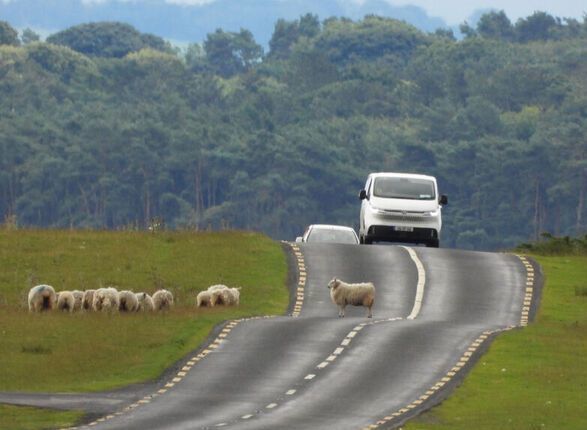Frederick Douglass in the 1840s
By James Brosnahan and Dan VanDeMortel
In honor of February’s annual Black History month we celebrate the meaningful influence the Irish had on the famous black abolitionist Frederick Douglass during his nineteenth century travels to Ireland.
Douglass embarked by steamship to Dublin, landing in August 1845 and just before the Famine began.
Douglass never knew his birthdate or age, the latter posthumously determined as 1818. He was born into slavery in Maryland as Frederick Augustus Washington Bailey, the son of a slave mother and, presumably, a white master of undetermined Irish origin. He never knew his father and was separated from his mother at infancy.
Douglass fled his dehumanizing bondage at age 20. Successfully arriving in New York, he married the black woman who aided his escape, moved to Massachusetts, and changed his surname to Douglass.
Douglass educated himself because it was illegal for anyone else to do so. He read voraciously and absorbed the great debates and speeches of the time. Under William Lloyd Garrison’s American Anti-Slavery Society sponsorship, he eventually joined the abolitionist speaking circuit, honing his oratory based on his own life experience and Biblical teachings.
In May 1845, Douglass published, "Narrative of the Life of Frederick Douglass, An American Slave," the immediate success of which proved a double-edged sword. The autobiography quickly made him the most famous black person in the United States. However, that notoriety had a price: his prominence sparked death threats and potential capture and return to his master under the draconian Fugitive Slave Act.
To avoid harm, Douglass’ friends and mentors suggested a lecture tour of the British Isles, where slavery had been abolished. Garrison also saw this as an opportunity to develop relationships with British abolitionists and raise the American anti-slavery movement’s profile internationally. Just 27, and having never travelled overseas, Douglass reluctantly agreed, leaving his family for a voyage into the unknown.
Douglass set off for Dublin via Liverpool on a two-week Atlantic crossing, accompanied by a white abolitionist and family group of singers. He attempted to purchase a first-class ticket, but the captain forced him into steerage, the lowest class. Undaunted by this inauspicious start, Douglass resolved to escape his slave identity, seek self-improvement and self-knowledge in the land of his paternal ancestors, spread abolitionism, and – like celebrities today – promote his lectures and sell books.
After two days in Liverpool, Douglass sailed for Dublin to connect with a Quaker printer who had agreed to print an Irish edition of "Narrative." By mid-September, Douglass had delivered numerous lectures to overflow crowds at venues ranging from Dublin’s City Hall to a local prison. In contrast to his hostile treatment back home in the U.S., the positive Irish reception astonished Douglass. He wrote he “was not treated as a color, but as a man.”
Douglass’ visit occurred amidst one of many struggles for Irish independence. He arrived aware of Ireland’s history of British colonization and religious, economic, and political oppression. He was also knowledgeable of the writings and speeches of famed Irish nationalist Daniel O’Connell, who, uncommon for politicians, was also a fierce abolitionist.
The highlight of Douglass’ Dublin stay came on September 29 when he heard O’Connell at a Repeal meeting at Conciliation Hall. Douglass was greatly impressed by O’Connell’s presence and words: calming, persuasive, and more powerful than any he had ever heard.
Douglass found O’Connell’s 75-minute speech “skillfully delivered, powerful in its logic, majestic in its rhetoric, biting in its sarcasm, melting in its pathos, and burning in its rebukes.”
He was introduced to O’Connell, who generously encouraged him to address the audience. Douglass accepted, beginning with apprehension and self-deprecation, then finding his oratorical groove, charming the audience with his life experience, vast knowledge, and abolitionist passion. He concluded by praising O’Connell, declaring that his enslaved compatriots needed “a black O’Connell” to liberate them. He finished by borrowing O’Connell’s exhortation to “agitate, agitate, agitate.”
In early October, Douglass and his companions set off for stays and lectures in Cork, Limerick, and Belfast, with briefs stops in Wexford, Waterford, and, as he recounted, “the hill of Howth to the Giant’s Causeway, and from the Giant’s Causeway to Cape Clear.”
With few railroads available, he traveled via arduous horse-and-carriage trips through often windy, rainy, coastal mountains and hilly countryside. He organized his own itinerary, helped finance the tour, and personally transported and sold his book. The accompanying singers and Douglass, a lover of music, also sang at some of these gatherings. In return, he sometimes heard Irish laments, which reminded him of plantation life.
Douglass’ intended four-day Irish stay mushroomed into four months, over 50 speeches, and many book sales. He drew large crowds, observing, “I saw no one that seemed to be shocked or disturbed by my dark presence. No one seemed to feel himself contaminated by contact with me.” Hostility was the exception, not the rule, and Douglass scarcely mentioned it in his writing. He wanted to draw a strong contrast with American hostility to blacks.
Douglass saw dire poverty, worse than what he heard about. The first stages of potato crop failure cast an early shadow, of what would eventually yield a million deaths and a million leavings on small boats by haggard people carrying all their worldly possessions.
The British penal laws that lasted a hundred years in the 1700s commanded this poverty. Disturbed by what he witnessed, especially among Catholics, Douglass wrote, “I see much here to remind me of my former condition, and I confess I should be ashamed to lift up my voice against American slavery, but that I know the cause of humanity is one the world over.” His unquenchable thirst for knowledge had broadened Douglass’ view to include the sufferings of other peoples.
Unfortunately, biased by his own religious upbringing and strong temperance lifestyle, and desire to win over temperance and abolitionist leaders and British guests, especially Protestants, Douglass occasionally blamed the victims for alleged drunkenness and backwardness.
His overarching compassion was moderated by anti-Catholicism and elitism, which, as he wrote, was repulsed by “human misery, ignorance, degradation, filth, and wretchedness.” Despite paying tribute to O’Connell in Protestant Belfast, he strategically avoided mentioning O’Connell’s cause, or the plight of Catholics, so as not to alienate his audiences.
Protestant-Catholic tensions were challenging to navigate, a divide difficult to quickly discern unlike American skin color differences. To impress diverse audiences dominated by either religion or Irish nationalists or British loyalists, Douglass sometimes became engulfed and sidetracked in controversies beyond his experience and abolitionist message.
And his accurate pronouncement that “there was nothing like American slavery on the soil on which he now stood” was difficult for some to accept.
After touring Scotland, Wales, and England, Douglass finally boarded for home in April 1847, once his freedom had been purchased by a group of women abolitionists in England. Freedom, however, still meant segregated quarters, not first-class return travel.
Douglass’ tour impressed him greatly. The thinkers and debaters he encountered gave him greater perspective on his personal situation and abolitionism. Treatment as an equal for the first time in his life proved a liberating experience, transforming the autobiographical orator into a commenter on domestic and international issues.
As Douglass trip’ writers Christine Kinealy and Tom Chaffin have observed, Douglass’ do-it-yourself tour into tangled Irish politics and inequality also enhanced his self-reliance, independence, sympathy for the downtrodden, and quest for and ability to obtain political compromise.
Although many Irish Americans opposed his civil rights efforts, Douglass viewed the Irish in America and Ireland as a persecuted people and drew parallels between them and blacks. O’Connell’s adherence to non-violent societal change left a strong impression.
Douglass viewed his efforts on behalf of Irish freedom as an instructive tale for blacks: “What O’Connell said of the history of Ireland may with greater truth be said of the negro’s. It may be ‘traced like a wounded man through a crowd, by the blood.’”
In 1887, Douglass returned to Ireland. His friends from four decades past were dead, but he stayed with several of their children. His visit coincided with the Home Rule Irish independence political movement.
Douglass had previously encountered Home Rule and its supporters in America, a cause that divided black opinion due to historical discrimination and anti-abolition sentiment by Irish Americans (despite O’Connell’s admonition against both). Douglass, however, distinguished Ireland’s Irish from Irish Americans and sided with Home Rule, writing, “I am for fair play for the Irishman, the negro, the Chinaman, and for all men of whatever country or clime, and for allowing them to work out their own destiny without outside interference.”
Douglass once remarked, “He who really and only feels for the American slave, cannot steel his heart of the woes of others; and he who thinks himself an abolitionist, yet cannot enter into the wrongs of others, has yet to find a true foundation for his anti-slavery faith.”
American slavery is blessedly gone, but as current Douglass-themed Belfast murals and Cork and Waterford plaques attest, his words and spirit still live on in Ireland.
James Brosnahan and Dan VanDeMortel have published Northern Ireland Presidential and Congressional scorecards, have frequently visited Ireland, and have written about Irish political and legal affairs.








